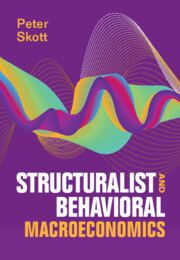Book contents
- Frontmatter
- Contents
- Figures
- Preface and Acknowledgments
- 1 Introduction: The State of Macroeconomics
- 2 The Lucas Critique and Representative Agents
- 3 Household Consumption and Saving
- 4 Saving in a Corporate Economy
- 5 Phillips Curves and the Natural Rate of Unemployment
- 6 Fairness, Money Illusion, and Path Dependency
- 7 Earnings Inequality, Power Bias, and Mismatch
- 8 Macroeconomic Adjustment and Keynes’s Instability Argument
- 9 Growth and Cycles
- 10 Endogenous Growth Cycles with or without Price Flexibility
- 11 Secular Stagnation and Functional Finance
- 12 Concluding Comments: Evidence-Based Macroeconomics and Economic Theory
- References
- Author Index
- Subject Index
8 - Macroeconomic Adjustment and Keynes’s Instability Argument
Published online by Cambridge University Press: 10 November 2023
- Frontmatter
- Contents
- Figures
- Preface and Acknowledgments
- 1 Introduction: The State of Macroeconomics
- 2 The Lucas Critique and Representative Agents
- 3 Household Consumption and Saving
- 4 Saving in a Corporate Economy
- 5 Phillips Curves and the Natural Rate of Unemployment
- 6 Fairness, Money Illusion, and Path Dependency
- 7 Earnings Inequality, Power Bias, and Mismatch
- 8 Macroeconomic Adjustment and Keynes’s Instability Argument
- 9 Growth and Cycles
- 10 Endogenous Growth Cycles with or without Price Flexibility
- 11 Secular Stagnation and Functional Finance
- 12 Concluding Comments: Evidence-Based Macroeconomics and Economic Theory
- References
- Author Index
- Subject Index
Summary
Keynesian involuntary unemployment describes a market failure: market forces may be incapable of bringing the economy to full employment. Wage and price stickiness are not the problem. Keynes took prices to be flexible and viewed sticky nominal wages as desirable: flexibility would tend to make the economy violently unstable. The IS-LM model provides a decent representation of the analytical skeleton behind Keynes’s fix-wage equilibrium but leaves out dynamic forces that are central to Keynes’s instability argument. By including one of these forces – the effects of expected inflation on real interest rates – in a formal model, Tobin showed that wage flexibility does not ensure the stability of full employment. The model’s assumption of an exogenous money supply misrepresents the real-world behavior of central banks as well as contemporary theory. Introducing a Taylor rule, stability can be obtained if the zero lower bound does not constrain interest rates – a result anticipated by Keynes: “only a foolish person would prefer a flexible wage policy to a flexible monetary policy”, he argued, while warning about the ineffectiveness of the policy in a liquidity trap.
Keywords
Information
- Type
- Chapter
- Information
- Structuralist and Behavioral Macroeconomics , pp. 203 - 227Publisher: Cambridge University PressPrint publication year: 2023
